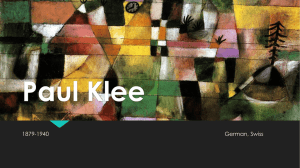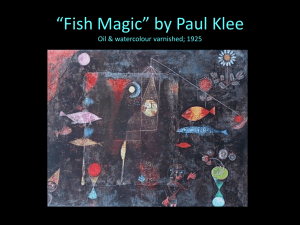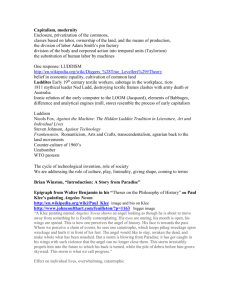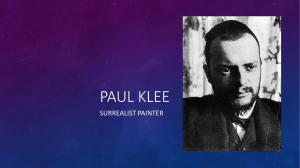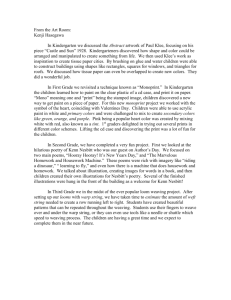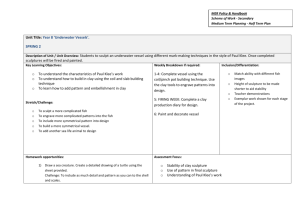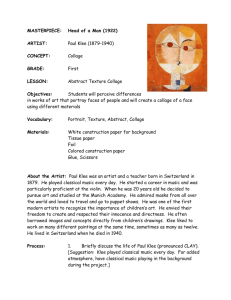Step 1 - Introducing the Paul Klee Slideshow Guide
advertisement
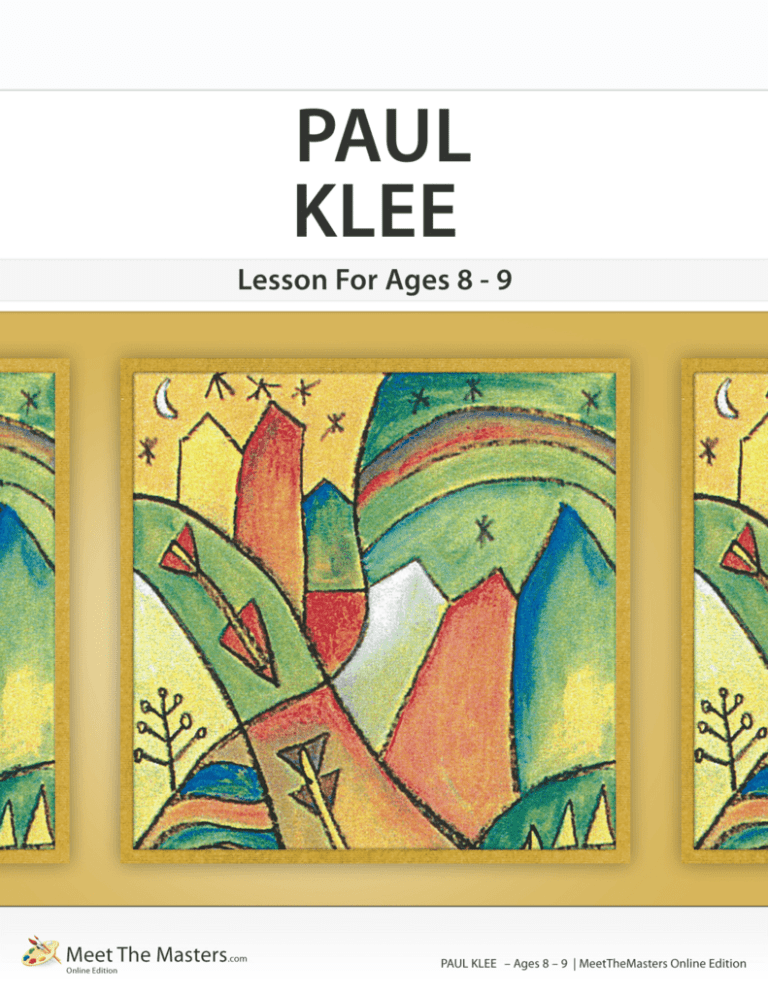
PAUL KLEE– AGES 8 – 9 | ONLINE EDITION Step 1 - Introducing the Paul Klee Slideshow Guide BEGIN READING HERE MOTIVATION Have you ever had to make a choice -- like deciding between a game to play or a book to read or food to eat in a restaurant? Today’s artist had to make a very important decision. He had to choose between being an artist or a musician! He was an excellent musician. He started playing when he was only seven years old and was performing with an orchestra by age eleven. Can you guess what instrument he played? Listen carefully to some music by his favorite composer, Mozart. ASSEMBLY AUDIO (WHILE MOZART’S CASSATION ALLEGRO PLAYS, PANTOMIME VIOLIN PLAYING.) Click Audio to play music Can you tell what instrument we heard? (VIOLIN) Yes, he was a violin player. His name is Paul Klee, and he was surrounded by music as a child. His father was a music teacher, and his mother was a singer. Klee loved music, but he also enjoyed art as a child. His grandmother gave him a box of colored chalk. She would read him fairy tales and have him draw pictures of the stories with chalk. Do you have a favorite fairy tale story that you would like to draw? When he grew up he chose to become an artist for his job, but he always loved music. Click Start Lesson To Begin DEVELOPMENT 1. EYE OF BEETHOVEN NOTEBOOK Paul Klee was a very good student in school. On this math homework page, he drew this funny looking man and, above, another famous music composer, Beethoven. Do you think his teacher liked seeing these drawings? Can you recognize what signs are right below Beethoven’s face? (MUSICAL NOTES) Yes, they are musical notes. When learning how to play an instrument, you learn to read music just like you learn to read words in a book. These four musical notes written by Beethoven are very famous. You will hear them in Beethoven’s Fifth Symphony. Listen for “da, da, da, DAH” at the beginning and repeated a few times. I will signal with my hand each time those notes are played. Have you heard this music before? Click Next To Change Slide 1 PAUL KLEE – Ages 8 – 9 | MeetTheMasters Online Edition PAUL KLEE– AGES 8 – 9 | ONLINE EDITION ASSEMBLY AUDIO (PLAY OPENING OF BEETHOVEN’S FIFTH SYMPHONY AND SIGNAL WHEN FOUR NOTES ARE PLAYED.) Click Audio to play music (Check if hand is raised when four notes are played.) Have you heard this music before? (YES) As a young man, Paul Klee was required to serve in the German military. He was given a desk job at an air force base, which had a flying school, but in his free time he painted. Click Next To Change Slide 2. BIRDS SWOOPING DOWN AND ARROWS What was Klee thinking of when he painted this? (AIRPLANES AND/OR BIRDS FLYING) Klee witnessed several plane crashes while pilots were learning to land their planes at the airport. Instead of showing realistic planes in tragic accidents, he painted bird and arrows swooping down from the sky. It was his way of showing MOVEMENT, and he used them in many of his paintings, as you will see today. Click Next To Change Slide 3. PHOTO OF ARTIST IN STUDIO Paul Klee was very busy as a painter, often working on more than one canvas at a time. He completed nearly 8,000 paintings in his life! He taught art at a number of art schools in Europe and was friends with many other famous artists. Notice the four paintings on the easels behind him. Can you guess which of these paintings I’m going to show next? Click Next To Change Slide 4. SENECIO, HEAD OF A MAN Did you guess this one? What do we call the people who wear funny costumes at the circus and make us laugh? (CLOWNS) Klee loved circus clowns and painted them often. Does the face look realistic, like a real clown? (NO) Klee painted in his own special way. He used color, shape and line to make the clown’s face look different. This kind of art is called ABSTRACT, because it doesn’t look like the real thing. 2 PAUL KLEE – Ages 8 – 9 | MeetTheMasters Online Edition PAUL KLEE– AGES 8 – 9 | ONLINE EDITION Do you notice that his eyebrows don’t match? Klee painted the dark eyebrow on the right like an arrow pointing our eyes in a circle around the face. (INDICATE CLOCKWISE AROUND THE FACE) Klee got our eyes to travel as we look at the painting. Klee married Lily, a piano teacher. They would invite friends over in the evening and entertain them with their musical performances. She would play the piano while he accompanied her on the violin. They had a son named Felix. Let’s look at one of Klee’s paintings of their child. Click Next To Change Slide 5. PORTRAIT OF FELIX Is this an oil painting or a WATERCOLOR? (WATERCOLOR) What colors did Klee use to create his work? (BLACK AND WHITE) But he really only needed one color, black, because the white we see is actually the white paper. He demonstrated VALUE in this painting. VALUE in art means using light and dark of the same color, different shades of the same color. What is the darkest color value in this painting? (BLACK) What is the lightest color value? (WHITE) How did he get the black lighter and lighter? (ADDED WATER) That’s right. When painting with watercolor, you add more water to get lighter values like these different shades of gray. Klee’s wife worked outside of the house as a piano teacher while he stayed at home painting and taking care of Felix. While the baby was napping, Klee would paint in the kitchen of their small home. He would also do all the cleaning and cooking. Can you guess one of his favorite dishes to cook? Click Next To Change Slide 6. AROUND THE FISH Did you guess fish? Klee liked to fish in his spare time and would cook the fish he caught. Klee called this painting, Around the Fish, because he wants our eyes to travel in a circle around the fish on the blue plate. Can you guess where he wanted our eyes to start traveling after looking at the fish? (AT THE ARROW) He even added an exclamation point for emphasis. Moving counter clockwise as the arrow tells us, can you recognize some of the things around the fish? (TAKE SEVERAL ANSWERS) Klee painted from his imagination so we might not be able to recognize everything he painted. Next our eyes will travel around a magical forest. Click Next To Change Slide 3 PAUL KLEE – Ages 8 – 9 | MeetTheMasters Online Edition PAUL KLEE– AGES 8 – 9 | ONLINE EDITION 7. LANDSCAPE WITH YELLOW BIRDS What do you think Klee wanted you to notice first? (YELLOW BIRDS) Yes, he painted them in a bright color to get our attention. Notice that most of the lines and shapes in this painting are curved. To make his paintings look more interesting, sometimes Klee would cut them into sections and put them back together in a topsy-turvy way. Originally, the red tree was in the middle. Klee cut the picture in half, right down the middle of the tree, and reversed the pieces. Now the tree halves are on the outside of the composition. He glued the pieces of canvas onto cardboard but left a space between them, which he colored in to match the background. He added the yellow birds by putting them in a circle so our eyes will make the journey around the forest. He even cut a bird in half and added the pieces to the middle. Can you point to that? Now, let’s take a look at a tree house that we might find in this imaginary magical forest. Click Next To Change Slide 8. TREE OF HOUSES Wouldn’t it be fun to play in this tree house? Let’s have our eyes take a walk up this big tree by joining the child at the bottom ready to climb the ladder. Where do you want to stop on the way up the tree? (SEVERAL RESPONSES) Now that we are already up at the top, how does Klee get our eyes to move down again? (BIRD POINTING DOWN) In Tree of Houses, he glued two pieces of fabric to a board, leaving a border all around. (HOLD UP PIECE OF BURLAP) He liked the TEXTURE and rough feel of the fabric. He didn’t want it to be perfectly smooth as he painted right on the fabric. If you look closely, you can see the fabric in the background. TEXTURE is how something feels and looks. Can you name something in this room that might have a rough or smooth texture? (SEVERAL RESPONSES) In a painting, we have to feel the TEXTURE with our eyes since we can’t feel it with our hands. Klee was always trying new things. He painted on burlap, silk, cardboard, and glass. He would use both oil paints and watercolor in the same painting. He even added crayons to some paintings. Click Next To Change Slide 4 PAUL KLEE – Ages 8 – 9 | MeetTheMasters Online Edition PAUL KLEE– AGES 8 – 9 | ONLINE EDITION 9. INSULA DULCAMARA So far we have traveled to a magical forest and a tree house. Where do you think we are now? (TAKE SEVERAL RESPONSES) This painting is titled The Bittersweet Island. Can you see an island in the painting? The dark black lines are the coastline of the island. Let’s follow the coastline around. (POINT OUT THE OUTLINE) Are the lines always the same width? (NO) What do you think some of the other black lines represent? (CAVE, PLANT, TREE, SNAKE, HOUSE, SKULL, WHALE) Those are good guesses. Klee liked having people come up with their own ideas about what his lines and symbols meant. Can you find the sun or moon rising and then going down? (SEMI CIRCLES AT TOP) Can you point out the ship that will take us to this island? (UPPER RIGHT) For Paul Klee, this island represented the world and all of life. Why do you think he called it a bitter and a sweet island? (TAKE SEVERAL RESPONSES) Klee is telling us that life could be bitter/sad and sweet/happy at the same time. Life had become happy and sad for Paul Klee. He was successful as an artist, but he became quite ill during the last five years of his life. It caused his hands to become very painful and twisted out of shape. It became difficult for him to hold a paintbrush, and he could only paint heavy black lines. Click Next To Change Slide Click Next To Change Slide 10 HEROIC STROKES OF THE BOW There was something else he could no longer do as a result of his illness. Let me give you a clue. ASSEMBLY AUDIO (BEETHOVEN VIOLIN CONCERTO IN D MAJOR OP 61) Click Audio to play music Can you guess what he had to give up? (PLAYING THE VIOLIN) Yes, he had to give up playing his beloved violin, and he shows us his feelings in this painting. Does the music we just listened to sound happy like the music we heard at the beginning of today’s lesson? (NO) How does the music sound different? (SLOW, SAD) Look at the black lines going back and forth in this painting. What do we call the long piece, which is used to strike the strings of the instrument and create the sound? (BOW) Yes, these black lines represent the bow going back and forth across the violin. Klee’s hands could no longer hold the bow and make beautiful music on the violin. In between 5 PAUL KLEE – Ages 8 – 9 | MeetTheMasters Online Edition PAUL KLEE– AGES 8 – 9 | ONLINE EDITION the strokes of the bow, Klee painted marks or symbols. What could they be? (MUSICAL NOTES, PART OF THE VIOLIN ITSELF) Have you ever heard of the expression: “I’m feeling blue today.” How are you feeling? (SAD) Klee used the color blue to show his feelings about not being able to play the violin anymore. He could no longer play music, but he continued to paint pictures about music. Click Next To Change Slide 11 KETTLEDRUMMER In this painting, he features a different musical instrument. To figure out this new instrument listen carefully to this music. I will signal every time the instrument is played. ASSEMBLY AUDIO (AS THE ENDING OF TCHAIKOVSKY’S 1812 OVERTURE PLAYS, PANTOMIME PLAYING DRUM WHEN IT IS HEARD.) Click Audio to play music END OF AUDIO Have you figured out the instrument? (DRUM) Klee called this painting Kettledrummer. We see only a few simple lines that show a musician with drumstick arms. One arm is raised high before making the booming sound on the kettledrum like in the music that we just heard. Did Klee paint the color neatly inside the lines? (NO) It is almost messy in the way the red and black are applied. CONCLUSION As Klee’s illness got worse, holding a paintbrush became even more difficult. But that didn’t stop him from painting pictures like Kettledrummer. And so he was still able to be a part of what he loved so much: art and music. 6 PAUL KLEE – Ages 8 – 9 | MeetTheMasters Online Edition PAUL KLEE– AGES 8 – 9 | ONLINE EDITION Click Next To Finish Lesson to exit this unit click Back To Units 7 PAUL KLEE – Ages 8 – 9 | MeetTheMasters Online Edition PAUL KLEE– AGES 8 – 9 | ONLINE EDITION Step 2 - Learning From: Paul Klee Abstract Shape Klee used his imagination to draw his ideas. His work does not look real, so we call it abstract. Abstract is simple shape and line. We can use simple shapes and lines to make an abstract fish. Draw your own fish that is abstract. Realistic House Abstract Arrow Fish Movement Klee used shape, line and color to make our eyes move around his compositions. Repeating a line, color or shape can make our eyes move. Still Moving Use a shape of your own and repeat it to make your eye move. Still Moving 8 PAUL KLEE – Ages 8 – 9 | MeetTheMasters Online Edition PAUL KLEE– AGES 8 – 9 | ONLINE EDITION Color Can Create Movement Klee used color to make our eyes move. Color the shapes in the first rectangle all the same color. In the second rectangle color the W shapes using warm colors, then use cool colors for the C shapes. Warm colors move forward, and cool colors move away. Still Moving Pattern Repeating lines and shapes can make patterns. Using an interesting line, create a pattern with line and color. Next create a pattern with shape and color. Line Shape Making sound visual Klee often painted sound. Use line to make a bold pattern a loud drum might make. Then let’s try the gentle line pattern of a soft flute. Drum Flute Think of another interesting sound And write it on the blank below. Draw it as a visual pattern we can See in the rectangle at right. Your sound 9 PAUL KLEE – Ages 8 – 9 | MeetTheMasters Online Edition PAUL KLEE– AGES 8 – 9 | ONLINE EDITION Abstract Neighborhood or Landscape with Movement We have learned several ways that Klee moved our eyes with line, shape and color. Add a few abstract arrows, birds, or fish to the composition below to make our eye move. Now add patterns to two or three shapes to add interest and more movement. 10 PAUL KLEE – Ages 8 – 9 | MeetTheMasters Online Edition PAUL KLEE– AGES 8 – 9 | ONLINE EDITION Color your composition keeping in mind that warm colors come forward and cool colors move back. Also spread out your colors and balance them so your eyes move around the neighborhood. The last few pages of this section contain the Art Activity for Paul Klee. This step-by-step outline will be a guide for instructing your child(ren) through the activity. The parent/instructor should review all steps necessary to complete this project before beginning any work. Cut out the Artist Profile Slip below and attach it to the back of the completed art project. PAUL KLEE (Klay) Swiss 1879-1940 Swiss artist, Paul Klee’s inspiration came from nature, music, and a wonderful imagination. The children built on his themes and their imaginations to create a fanciful composition full of movement, color, and texture. ART ACTIVITY EMPHASIS: Abstract Compositions MEDIA: Paper, Black Crayon, Tempera Wash PAUL KLEE (Klay) Swiss 1879-1940 Swiss artist, Paul Klee’s inspiration came from nature, music, and a wonderful imagination. The children built on his themes and their imaginations to create a fanciful composition full of movement, color, and texture. ART ACTIVITY EMPHASIS: Abstract Compositions MEDIA: Paper, Black Crayon, Tempera Wash 11 PAUL KLEE – Ages 8 – 9 | MeetTheMasters Online Edition PAUL KLEE– AGES 8 – 9 | ONLINE EDITION Step 3 - Working With: Art Activity Instructions ARTIST Paul Klee (Klay) (1879-1940) Swiss ART ELEMENTS Line, color and texture MEDIA Paper, black crayon and tempera wash PRINT Southern Gardens LEVEL Intermediate EMPHASIS Abstract composition with line, texture and color VOCABULARY Abstract, movement, design, pattern, line, texture, secondary, warm and cool colors SUGGESTED MUSIC Music of the 1900s MATERIALS FOR INSTRUCTOR AND STUDENTS One 12” x 18” light blue, light lavender, pale green, or pale yellow construction paper (NOT bright) (Example: 8 lt. blue + 8 lavender + 8 pale green + 8 pale yellow = 32 total) Paper towel Artist profile slip One 8½” x 14” TAG board to trace for framing edge (One set of 40 to use and return to tote) Black crayons 9” paper plates 4 dabs (nickel size) of tempera paint - magenta, yellow, turquoise, white Watercolor paintbrushes (rounded and soft) Water cups Water pitcher (for instructor only) Pencil PREPARATION Display the Klee print in front of the room. Tape your 12” x 18” construction paper to the board, vertically or horizontally. Have 8½” x 14” TAG board, black crayon, prepared paper plate palette with the four tempera colors, paintbrush and water cup close by. SET-UP [ 5 minutes ] 12 PAUL KLEE – Ages 8 – 9 | MeetTheMasters Online Edition PAUL KLEE– AGES 8 – 9 | O NLINE EDITION Distribute the materials: SUPPLIES: [3] Black crayon, paintbrush, water container PAPER: [4] One 12” x 18” colored, construction paper, one 8½” x 14” TAG board (to be collected), paper towel, and artist profile slip Volunteer or teacher needs to help with: Preparing and distributing paint PALETTES, Distributing and pouring WATER when needed. ORIENTATION [ 5 minutes ] Our master artist Paul Klee came from what country? (SWITZERLAND) Is Klee’s style abstract or realistic? (ABSTRACT) What do we mean when we say Klee’s art is abstract? (DOES NOT LOOK REAL) What kinds of things inspired Klee to paint? (IMAGINATION, LANDSCAPES, NATURE, MUSIC) Klee’s work has lots of movement. How does he make our eyes move around his paintings? (WITH LINES, COLORS, TEXTURES, AND SHAPES) Let’s get ready to draw and paint an abstract landscape with movement just like Paul Klee. DEMONSTRATION AND ACTIVITY Have the students repeat each step immediately with their materials: ORGANIZE YOUR WORK AREA [ 3 minutes ] Using your pencil print your name on the back of your 12” x 18” colored paper. Choose to arrange it vertically or horizontally on your desk (demonstrate). Center the TAG board on top of your colored paper. Put your paintbrush and water cup on your paper towel in the upper corner of your desk. Put your pencil, black crayon, and artist profile slip in the other corner. DRAWING THE FRAMING EDGE [ 5 minutes ] (The instructor will need to demonstrate this step with all eyes watching! ***This step could be prepared ahead of time by teacher or volunteer) Have the students center the TAG board on their colored, construction paper so that it has equal space all the way around. Carefully and slowly outline the TAG board with your black crayon. Remove the TAG board. These can be collected now and stored in tote. Your design will be within this framing edge to give it a finished look. 13 PAUL KLEE – Ages 8 – 9 | MeetTheMasters Online Edition 1 PAUL KLEE– AGES 8 – 9 | O NLINE EDITION CREATING YOUR ABSTRACT DESIGN [15 minutes] (Teacher should demonstrate with black crayon for visibility within the framing edge on the colored, construction paper) Using pencils, have the students draw two curving, moving lines, to look like a road or path. Start towards the top of either side of the paper, at least three fingers down from the top. Draw two dots two fingers apart. Draw two, curving lines from these points that widen and continue down to the bottom, framing edge. At the bottom the lines will be at least an open hand’s width apart. Draw two or three straight or curving lines from the top to the bottom and from one side to the other to break up the space in an interesting way. (Drawing sample on following page.) Add three to five squares or rectangles with triangle shapes on top to resemble houses. Let the bottoms follow a straight or curving line. Fill three to five sections with different patterns to add texture and movement. Find different spaces to add a bird, fish, arrow, moon or sun in the style of Klee, and help move your eyes around the composition. Refer to the Learning Packet to recall simple abstraction and the way line, shapes, and color can move our eyes! Keep your design simple, and try to break up the space into interesting shapes. Trace all your best lines with your black crayon. Press hard to create a heavy wax resist. Now we have a very abstract neighborhood or landscape! 2 3 4 5 ADDING COLOR WITH WATERCOLOR WASH [ 15 minutes ] Review color mixing by having each student mix a small amount of each secondary color on his or her palette. Take lightest color first (yellow + magenta = orange, yellow + turquoise = green, turquoise + magenta = violet). Demonstrate the use of lots of water and a soft brush to gently wash in one color to each defined shape. Apply water to one shape at a time. Mix a color on the palette, dip brush in water, and then apply to the shape. White can be added to create tints of colors. 14 PAUL KLEE – Ages 8 – 9 | MeetTheMasters Online Edition PAUL KLEE– AGES 8 – 9 | ONLINE EDITION Refer to the Learning Packet for the way color can move our eyes around the composition, by balancing colors and contrasting warm and cool colors. (Warm colors come forward, and cool move back.) The black crayon defines the shapes and resists the paint. Stress painting light shapes first to dark shapes last so that palette and paints stay clean. Mix a little paint at a time and apply with lots of water. Students continue until they have a very colorful composition. Let dry, and stack under several, heavy books if paper curls. MOUNTING THE ARTIST PROFILE SLIP [ 2 minutes ] (Profile slips for each artist are provided. They give a brief description of the artist, the technique, and the media used in the art activity. They should be mounted on the back of each art project after it is completed.) Write your name on the front of the artist profile slip. Using glue, mount the profile slip on the back of your artwork. Encourage students to discuss their artwork at home using this artist slip of information. CONCLUSION Your abstract landscapes are so colorful and captivating. Would you like to take a walk into these imaginary worlds you have created. Would you be scared or excited? Paul Klee would be very proud of you! THIS CONCLUDES THE PAUL KLEE UNIT. 15 PAUL KLEE – Ages 8 – 9 | MeetTheMasters Online Edition
